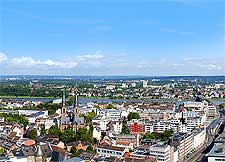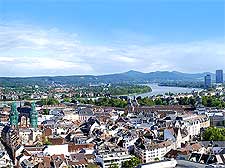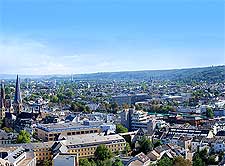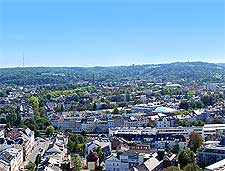Bonn History Facts and Timeline
(Bonn, North Rhine-Westphalia, Germany)

Bonn is thought to have begun as a small settlement of Germanic people in 30 BC. In particular, history records mention that a military settlement known as 'Bonna', complete with fortifications and a bridge, was established at this point on the River Rhine at some time between 13 BC and 9 BC.
In Roman times, this location became the site of a major camp and fortress. Remains of 'Castra Bonnensia' can still be found in the northern part of the modern city. According to legend, two Christian soldiers of Roman origin were murdered here. A church was built over their burial site and from this grew the Bonn Minster (Das Bonner Münster), which today lies at the very heart of the Old Town and ranks amongst the oldest churches in the whole of Germany.

History from Medieval Times to the 17th Century
In the year of 1244, Archbishop Konrad von Hochstaden announced that a defensive wall was to be constructed around Bonn. The settlement was also granted a town charter at this time. During the course of the next 300 years, the town became the acknowledged home of the court of the prince-elector of
Cologne. When the 16th Reformation arrived, Bonn resisted attempts by Luther to introduce the new religion. Then, from 1597, the town became the official capital for the ecclesiastical Electorate of Cologne.
Although the Thirty Years' War (1618 to 1648) was to wreak havoc in many German towns and cities, Bonn managed to survive mainly intact. However, in 1689, during the War of the League of Augsburg or 'Nine Years' War' (1688 to 1697), it was a different matter. As a result, the Habsburg candidate for the archbishopric was subsequently installed in the town.
Joseph Clemens von Bayern was responsible for an ambitious building plan, which included a grand baroque residence. His plans were taken on by his successor Clemens August, who was responsible for building the Electoral Palace (Kurfurstliches Schloss), a new Town Hall (now named the Altes Rathaus) and the Poppelsdorf Palace (Poppelsdorfer Schloss), amongst many landmarks.

From the Enlightenment to the Present Day
The Age of Enlightenment came to Bonn with the installation of its last elector, Max Franz von Habsburg. He established a university here and developed the southern part of the city into an appealing spa town. During this period of history, the city's inhabitants would have been able to listen to a youthful and undeniably talented Ludwig van Beethoven giving his earliest concert performances.
In 1794, Bonn saw itself under French rule. During the French occupation, which was to come to an end in 1814, the city lost its university and the church was divested of many of its former powers. In 1815, the Rhineland was brought within the control of Prussia. A new university was founded in the city, attracting such scholars as Karl Heinrich Marx.

With German defeat after World War One, Bonn began another period of occupation, this time under the command of Anglo-Canadian forces. Then, from 1920, it came under French control once more. The inter-war period was a time of unrest in Bonn, both politically and economically. When occupation finally ended, nationalist tendencies flourished here, as elsewhere in Germany.
During the 1930s, the local Jewish community was widely persecuted. Allied bombing in World War Two resulted in the destruction of the city centre. At the end of the war, Bonn came under the control of British forces. Then, in 1946, it became part of a new state known as North Rhine-Westphalia, being awarded the title of 'capital of West Germany' in 1949.
After German unification in 1990, Bonn lost its capital city status, but retained some government roles. As the Bundesstadt (Federal City) of Germany, it has become something of an unofficial second capital.
 Bonn is thought to have begun as a small settlement of Germanic people in 30 BC. In particular, history records mention that a military settlement known as 'Bonna', complete with fortifications and a bridge, was established at this point on the River Rhine at some time between 13 BC and 9 BC.
Bonn is thought to have begun as a small settlement of Germanic people in 30 BC. In particular, history records mention that a military settlement known as 'Bonna', complete with fortifications and a bridge, was established at this point on the River Rhine at some time between 13 BC and 9 BC.

 With German defeat after World War One, Bonn began another period of occupation, this time under the command of Anglo-Canadian forces. Then, from 1920, it came under French control once more. The inter-war period was a time of unrest in Bonn, both politically and economically. When occupation finally ended, nationalist tendencies flourished here, as elsewhere in Germany.
With German defeat after World War One, Bonn began another period of occupation, this time under the command of Anglo-Canadian forces. Then, from 1920, it came under French control once more. The inter-war period was a time of unrest in Bonn, both politically and economically. When occupation finally ended, nationalist tendencies flourished here, as elsewhere in Germany.